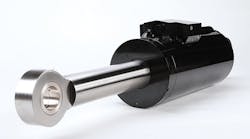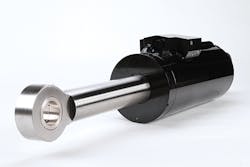This file type includes high-resolution graphics and schematics when applicable.
The shiny, polished look of a hydraulic cylinder’s chrome-plated piston rod stands out in stark contrast to the typical dirty environments that engage hydraulic systems. However, the familiar mirror-like surface of piston rods may gradually be replaced by alternatives with a more dull finish.
For years, hexavalent chromium has been a known carcinogen, so disposing of solutions used in hexavalent chrome plating can lead to serious health and environmental hazards. A widely used alternative has been trivalent hard chrome coatings. Regulations for working with trivalent chrome plating processes aren’t as strict as those using hexavalent, but some users feel the trivalent version produces a less-robust coating.
As a result, other processes have been adopted in the never-ending quest for piston rod surfaces with higher corrosion resistance and hardness, and tightly controlled finishes. One such surface finish is the Global Shield coating introduced by Parker Hannifin’s Mobile Cylinder Div. The proprietary coating technology was developed for high resistance to corrosion, impact, chemical attack, salt water, and acids. Cylinders protected with Parker’s Global Shield coating exhibited corrosion resistance up to eight times that of conventional coatings.
Global Shield with its single-layer, fully-dense, submicron structure has greater interfacial adhesion and higher impact resistance than electrolytic hard chrome (EHC). It exhibited almost no micro-cracking, chipping, or spalling and no delamination when compared to EHC plating using the Rockwell C-scale indentation test protocol. It has a minimum hardness of HRC 54, low friction, and high ductility and toughness.
The coating can be applied during original cylinder manufacture or during after-market cylinder maintenance. Coatings can be finished to a wide range of thicknesses, which is useful for resurfacing of damaged rods. The coating can also be stripped with no need for grinding, which facilitates removal and coating during remanufacture.
It can be applied to rod diameters from ½ to 15 in. OD (12 to 380 mm) and lengths to 13 ft. (3.9 6m). The standard thickness is 0.001 in. (25 μm), but it can be applied up to 0.020 in. (500 μm) thick for greater corrosion resistance.
The Global Shield coating is said to maintain a low-carbon footprint—it doesn’t use any hazardous chromium and only nominally uses other hazardous materials. It also requires less energy to produce than other corrosion-resistant coatings. Furthermore, it has 90% plating efficiency versus the 20% of EHC plating.
For more information on the Global Shield coating, call Parker’s Mobile Cylinder Div. at (800) 848-5575 or visit www.parker.com/mcd.



